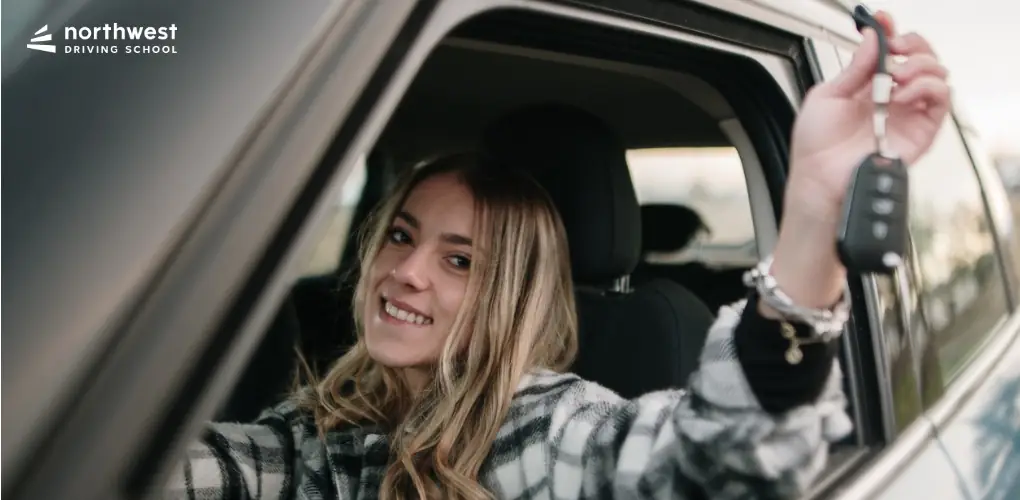- Driving School
Top Driving Safety Tips New Drivers Must Remember

Stepping behind the wheel for the first time can be as exhilarating as daunting. Whether you’re a teenager finally earning your driver’s license or an adult who has decided to learn to drive, the freedom of the open road comes with significant responsibilities.
Safety is paramount, and as a new driver, it’s crucial to understand the rules of the road and adopt a mindset of defensive driving and emergency preparedness. This blog post is a comprehensive guide for new drivers and parents looking to reinforce safe driving practices from the very beginning.
By navigating through these pivotal driving safety tips, you’ll protect yourself and contribute to a safer, more considerate driving community.
Table of Contents
Understanding Road Rules
Before you can confidently hit the road, you must thoroughly understand the rules and regulations governing traffic. This includes grasping the meanings of various signs and signals, knowing speed limits, and understanding the concept of right-of-way.
Read More: Navigating the Nevada Road Laws – A Guide for Learner Drivers
Know Your Traffic Signs
Road signs are the silent communicators that keep traffic flowing smoothly and safely. They inform you of hazards, provide directions, and even offer a glimpse into the local culture (have you ever wondered what the deal is with all those roundabouts in Europe?). From understanding the stop sign as a non-negotiable instruction to knowing the difference between a solid line and a broken line, mastering traffic signs is foundational to avoiding violations and accidents.
Respect Speed Limits
Speeding remains one of the leading causes of accidents, and new drivers are particularly vulnerable. Each road has its designated speed limit based on various factors, such as the level of traffic and the built environment. Adhere to these limits to avoid tickets and give yourself more time to react if something unexpected occurs.
Navigating Right of Way
Right of way determines who gets to proceed first when two or more vehicles conflict. Remember, the right of way is given, not taken. Ensure that you understand the basic rules surrounding it; for example, if you approach an intersection simultaneously with another driver, the vehicle on the left should yield to the car on the right.
Defensive Driving Techniques
Defensive driving is a set of skills that allow you to defend yourself against possible collisions caused by impaired drivers, drunk drivers, and poor weather conditions. It involves a proactive approach to the road that focuses on maintaining awareness and controlling risks.
Stay Alert and Be Prepared
The best defense is a good offense. Stay focused on the road ahead, check your mirrors regularly, and be ready to react to unexpected situations. Anticipate the actions of other drivers and make sure you have a plan for where to go if you need to take evasive action.
Maintain a Safe Following Distance
The 3-second rule for following distances ensures you have enough time to stop safely. Choose a fixed object on the road, such as a sign or a tree, and when the vehicle ahead of you passed it, count “one thousand one, one thousand two, one thousand three.” You are too close if you reach the object before you finish the count.
Avoid Distractions
With the rise of smartphones, distracted driving has become a significant concern. Texting, talking on the phone, eating, or fiddling with the radio are all distractions that can prevent you from giving your full attention to the road. Remember, a moment’s distraction can lead to a lifetime of regret.
Handling Adverse Conditions
New drivers must understand that not all driving situations are ideal. Weather can be a significant factor in driving safety, with rain, snow, fog, and darkness all bringing their challenges.
Rain and Hydroplaning
When it rains, roads become slick, and your car’s tires can lose traction. This is called hydroplaning, and it can be hazardous. To avoid hydroplaning, drive at a slower speed, and if you feel your car start to skid, ease off the gas and steer in the direction you want the car to go.
Navigating Snow and Ice
Winter driving presents unique challenges. It’s essential to equip your vehicle with appropriate tires and know how to respond if it skids or slides. Practice in an empty parking lot to build confidence and skill in these conditions.
Fog and Reduced Visibility
When driving in fog, reduce your speed and increase your following distance. If you have low beams or fog lights, use them. Remember that your visibility is reduced, as is the visibility of other drivers, so proceed with caution.
Night Driving
Darkness brings its challenges as our depth perception and peripheral vision are reduced. Ensure all your lights are working correctly, and reduce your speed to compensate for the limited visibility. Be especially cautious when driving where wildlife may be on the road.
Vehicle Maintenance
A well-maintained vehicle is not only more efficient and reliable, but it is also safer. Regular checks can prevent breakdowns and ensure your car operates at its best.
Checking Tire Pressure and Tread
Your tires are the only part of your car that touches the road, so keeping them in good condition is important. Proper tire pressure can improve fuel economy and handling, while good tread can prevent hydroplaning and other accidents.
Brakes and Lights
Your brakes stop your car, so you need to ensure they’re in good working order. Have your brakes checked at least once a year or more often if you hear unusual noises or experience any issues. Similarly, ensure all your lights are operational, as they are critical for seeing and being seen by other drivers.
Fluid Levels
Your car relies on various fluids, including oil, coolant, brake fluid, and windshield washer fluid. Checking these regularly can prevent engine damage, overheating, poor brake performance, and a dirty windshield during a crucial moment.
Emergency Preparedness
No driver wants to think about accidents or breakdowns, but preparing for these possibilities is crucial.
Reaction to Accidents
If you are involved in an accident, stay calm and take the necessary steps to ensure everyone’s safety. Call emergency services if required and exchange information with the other driver. If you can, take pictures of the scene and notify your insurance company immediately.
Breakdowns
If your car breaks down, try to move to the shoulder of the road or another safe location. Use your hazard lights to warn other drivers that you are in distress. If you need to exit the vehicle, do so on the side, away from traffic, and ensure your surroundings are safe before leaving.
General Emergency Situations
It’s a good idea to keep a well-stocked emergency kit in your car, including items like jumper cables, a first aid kit, a flashlight, a blanket, and non-perishable food and water. You might also consider joining a roadside assistance program for added peace of mind.


